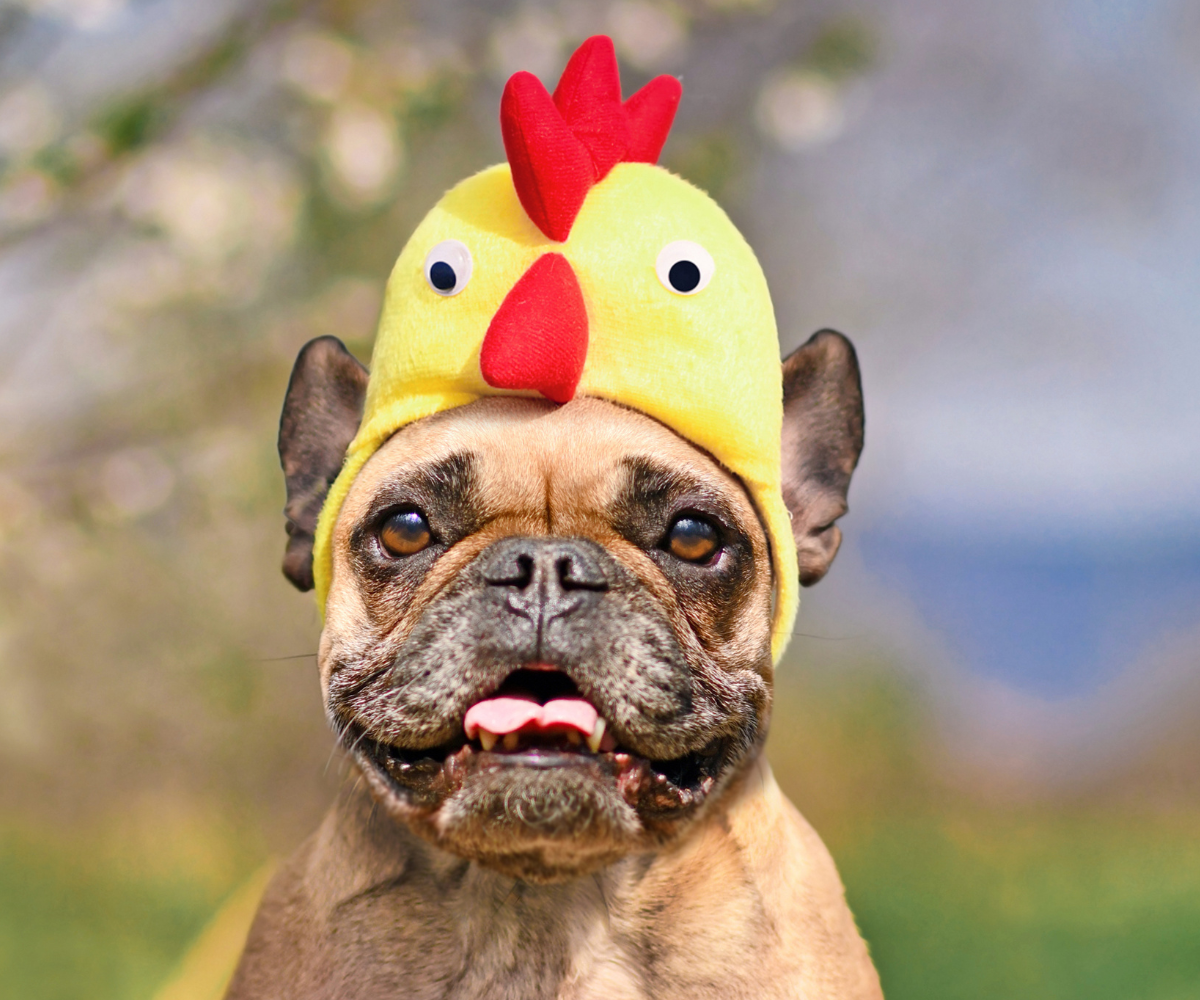Can Dogs Eat Chicken Skin? The Risks
Can Dogs Eat Chicken Skin? The Risks

Vet Reviewed

By: Sarah Hodgson
February 23, 2024
- Posted in Can Dogs EatDogs
Table of Contents
Dogs are notorious for their love of human food. They will beg for scraps at the dinner table and will do anything to get their paws on a tasty treat. However, not all human foods are safe for dogs to eat, and one of those foods is chicken. But let's dive a little deeper and talk about chicken skin.
Chicken skin is a popular snack for many humans, but is it safe for dogs to eat?
Let's dive in!
Can Dogs Eat Chicken Skin?
Chicken is a popular source of protein for both humans and dogs. However, when it comes to chicken skin, the answer is not as straightforward. While dogs can eat chicken skin, it should only be given to them in moderation due to its high-fat content.
Raw chicken skin is not recommended for dogs as it can contain harmful bacteria that can cause gastrointestinal problems. Cooked chicken skin is safer for dogs to consume, but it should still be given in moderation.
When considering feeding chicken skin to a dog, it is important to keep in mind the nutritional value and calorie count. Chicken skin is high in fat and calories, which can contribute to obesity and other health problems in dogs if given in excess.
What Happens If Dogs Eat Chicken Skin?
As we just mentioned, chicken skin is not toxic to dogs, but it is not recommended to feed it to them regularly. Chicken skin is high in fat, which can cause digestive upset, pancreatitis, and obesity in dogs.
If a dog eats a small amount of chicken skin, they may not experience any immediate harm. However, if they consume a large amount, they may develop diarrhea, vomiting, or abdominal pain.
It is important to note that feeding a dog chicken skin can also lead to long-term health problems. Regular consumption of chicken skin can cause weight gain, which can lead to obesity. Obesity is a serious health concern for dogs and can lead to a variety of health problems, including joint pain, diabetes, and heart disease.

What Are The Risks Of Giving Dogs Chicken Skin
While chicken skin may be a tasty treat for dogs, it is important to be aware of the potential risks associated with feeding it to them. Here are some of the risks of giving dogs chicken skin:
Digestive Issues
Chicken skin is high in fat, which can cause digestive upset in dogs. This can lead to vomiting and diarrhea, which can be uncomfortable and unpleasant for your furry friend. In some cases, excessive consumption of chicken skin can even lead to pancreatitis, a serious condition that can cause inflammation of the pancreas.
Obesity and Weight Gain
Feeding your dog too much chicken skin can also lead to obesity and weight gain. This is because chicken skin is high in calories and fat, and can quickly add up if your dog is eating it on a regular basis. Obesity can lead to a range of health problems for dogs, including joint issues, heart disease, and diabetes.
Allergies
Some dogs may be allergic to chicken, which can cause a range of symptoms including itching, redness, and swelling. If your dog has a chicken allergy, feeding them chicken skin can exacerbate these symptoms and cause discomfort.
Moderation is Key
While chicken skin can be a tasty treat for dogs, it is important to feed it to them in moderation. This means giving them small amounts of chicken skin as an occasional treat, rather than as a regular part of their diet. This will help to reduce the risk of digestive issues, obesity, and other health problems.
Factors to consider when feeding chicken skin to dogs
Feeding chicken skin to dogs can be a bit of a tricky subject. While it can be a tasty treat for your furry friend, there are several factors to consider before adding it to their diet.
Nutritional Value
Chicken skin is high in fat and calories, which can contribute to obesity and other health problems if consumed in large quantities. Therefore, it is important to keep portions small and infrequent.
Cooking Methods
How the chicken skin is prepared can also affect its nutritional value. Raw chicken skin can carry harmful bacteria, so it should always be cooked thoroughly before feeding it to your dog. Additionally, seasoning and spices used in the cooking process can be harmful to dogs, so it is best to avoid adding any additional ingredients.
Possible Allergies
Just like humans, dogs can have allergies or sensitivities to certain foods. Before feeding your dog chicken skin, it is important to monitor them for any signs of an allergic reaction, such as itching, vomiting, or diarrhea. If your dog shows any signs of discomfort or distress after eating chicken skin, it is best to avoid feeding it to them in the future.
Portion Control
As mentioned earlier, chicken skin is high in fat and calories, so it is important to keep portions small and infrequent. A small piece of chicken skin as a treat every once in a while is okay, but it should not be a regular part of your dog's diet.
What Should You Do If Dogs Eat Chicken Skin?
If a dog eats chicken skin, the first thing to do is to remain calm and assess the situation. Panicking won't help the situation but remaining composed will allow you to handle it effectively.
Note
It is important to note that chicken skin is high in fat and calories, and has almost no nutritional value for dogs. Feeding chicken skin may cause digestive upset, obesity, or diarrhea to your dog, and in the long term, it can lead to weight gain and pancreatitis with regular feeding.
If your dog has eaten chicken skin and is experiencing digestive upset, you should monitor them closely and ensure they have access to plenty of water. It is recommended to withhold food for 12-24 hours to allow their digestive system to rest and recover. However, if your dog's symptoms persist or worsen, it is recommended to contact your veterinarian for further advice.
In some cases, eating chicken skin may not cause any immediate health problems for your dog. However, it is still important to avoid feeding your dog chicken skin as part of their regular diet to prevent long-term health problems. Instead, you can provide your dog with a balanced and nutritious diet that meets their nutritional needs.

Safety and Preparation of Chicken Skin
When it comes to feeding your dog chicken skin, safety and preparation are crucial. Here are some important things to keep in mind:
Proper Cooking Techniques
Cooking chicken skin properly is essential to ensure that it is safe for your dog to eat. Boiling or baking the chicken skin is a safer option than frying it, as frying can add unnecessary fat and calories to your dog's diet. Additionally, avoid seasoning the chicken skin with any spices or herbs that may be harmful to your dog, such as garlic or onion.
Moderation
While small amounts of cooked chicken skin can be safe for your dog to eat, it is important to ensure that you are not overfeeding them. Feeding your dog too much chicken skin can lead to weight gain and other health issues. It is recommended to serve chicken skin as an occasional treat rather than a regular part of their diet.
It is also important to take precautions when serving chicken skin to your dog. Make sure that the skin is cut into small, bite-sized pieces to prevent choking, and never leave your dog unattended while they are eating. Additionally, be aware of the risk of salmonella contamination and make sure to handle and store the chicken skin properly to minimize the risk of foodborne illness.
Nutritional Considerations For a Balanced Diet
A balanced diet is critical to maintaining a dog's overall health and well-being. A balanced diet should include essential nutrients, vitamins, and minerals that meet the dog's daily calorie intake.
Breed and Size Considerations
Breed and size are important factors to consider when creating a balanced diet for dogs. Large breed dogs, for example, require a different diet than small breed dogs. Large breed dogs need a lower calorie intake to avoid obesity and other health problems. On the other hand, small breed dogs have a faster metabolism and require a higher calorie intake to maintain their energy levels.
Creating a Balanced Diet for Dogs
To create a balanced diet for a dog, it is essential to consider the dog's daily calorie intake and essential nutrients. Essential nutrients include protein, carbohydrates, fats, vitamins, and minerals. These nutrients are essential for maintaining a dog's overall health and well-being.
A balanced diet for dogs should include a variety of protein sources, such as chicken, turkey, beef, lamb, and fish. It is important to remove bones, fat, and skin from these protein sources to avoid digestive problems.
Carbohydrates such as brown rice, sweet potatoes, and green vegetables can provide energy and fiber to dogs. Fats are also essential for a dog's diet but should be limited to avoid obesity.
It is important to consult with a veterinarian or a board-certified veterinary nutritionist to create a balanced diet for dogs. These professionals can provide guidance on the appropriate daily calorie intake and the essential nutrients required for a dog's diet.
Alternatives to Chicken Skin
If you are looking for alternatives to chicken skin to feed your dog, there are plenty of options available. Here are a few:
- Lean Meat: Dogs can eat lean meat such as beef, pork, and lamb. These meats are high in protein and low in fat, making them a healthy alternative to chicken skin.
- Turkey: Turkey is another great alternative to chicken skin. It is low in fat and high in protein, making it a healthy addition to your dog's diet.
- Fish: Fish is a great source of protein and omega-3 fatty acids, which are essential for your dog's health. Just make sure to remove any bones before feeding it to your dog.
- Carrots: Carrots are a great source of fiber and vitamins. They are also low in calories, making them a healthy snack for your dog.
- Sweet Potatoes: Sweet potatoes are a great source of fiber and vitamins. They are also low in fat and calories, making them a healthy addition to your dog's diet.
- Green Beans: Green beans are low in calories and high in fiber. They are also a good source of vitamins and minerals.
It is important to note that while these alternatives are healthy for your dog, they should be fed in moderation and as part of a balanced diet. Always consult with your veterinarian before making any changes to your dog's diet.
Consulting with a Veterinarian
If you as a dog owner are unsure whether your dog can safely consume chicken skin, it is always recommended to consult with a veterinarian. A veterinarian can provide professional advice on your dog's health, dietary needs, and any potential risks associated with consuming chicken skin.
A veterinarian can also help identify if a dog has a sensitive stomach or any gastrointestinal issues that may be worsened by consuming chicken skin. Additionally, a veterinarian can help identify any allergic reactions that a dog may have to chicken skin.
The Bottom Line
So there you have it, while dogs can technically eat chicken skin, it is not recommended. Chicken skin is high in fat and calories, which can lead to weight gain and even pancreatitis in the long term. Additionally, consuming chicken skin can cause digestive upset and diarrhea in dogs.
It is best to stick to lean meats without the skin, such as boneless, skinless chicken breast, when feeding your dog. This will provide your dog with the necessary protein without the added fat and calories that come with chicken skin.
If you do decide to feed your dog chicken skin, it is important to do so in moderation and as a treat rather than a regular part of their diet. It is also important to ensure that the chicken skin is cooked thoroughly and free of any seasonings or spices that may be harmful to your dog.
Frequently Asked Questions
Are there any benefits to giving dogs chicken skin?
While chicken skin does contain protein and essential fatty acids, there are safer and more nutritious ways to provide these nutrients to your dog. Lean meats, such as chicken breast, are a healthier option for your dog.
What should I do if my dog has eaten a large amount of chicken skin?
If your dog has eaten a large amount of chicken skin, monitor them for signs of digestive upset, such as vomiting, diarrhea, and loss of appetite. If your dog develops any of these symptoms, contact your veterinarian.
Can dogs digest chicken skin properly?
Dogs have a digestive system that is designed to digest meat, including chicken skin. However, the high fat content of chicken skin can make it difficult for dogs to digest, leading to digestive upset.

Subscribe to Petfluence!
Get updates on the latest posts and more from Petfluence straight to your inbox.